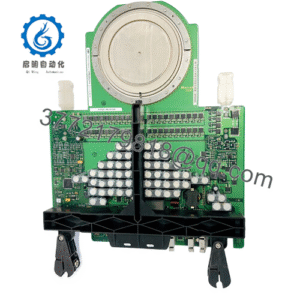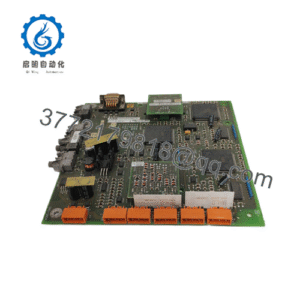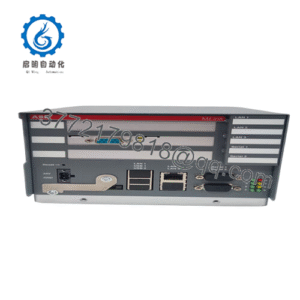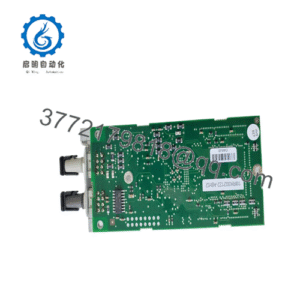Description
| Model Number | VMIVME-2510B |
| Brand | GE |
| Type | 3U VMEbus High-Density Configurable Digital I/O Module |
| I/O Channels | 32 Independent Channels (Configurable as DI or DO per Channel) |
| Input Specifications | 24V DC (±10%); 5mA Typical Current Draw; Adjustable Debounce (0.1ms–100ms) |
| Output Specifications | 24V DC (±10%); 2A Max Current Sourcing per Channel; 2.5A Overcurrent Protection (Auto-Reset) |
| VMEbus Compatibility | VME 3U, VITA 1-1994, IEEE 1014-1987; 32-Bit PIO/DMA Support |
| Fault Protection | Channel-to-Channel Isolation; 4 kV Surge Protection; Overcurrent/Overvoltage Protection |
| Signal Integrity | Built-In Noise Filtering (50/60 Hz Notch Filter); Output Slew Rate Control |
| Status Indicators | 32 Channel LEDs (Green = Active, Red = Fault); Global Power/Fault LED |
| Operating Temperature Range | -40°C to 70°C (Operational); -55°C to 85°C (Storage) |
| Dimensions | 100 mm (L) x 160 mm (W) x 23 mm (H) (3U VME Form Factor) |
| Weight | 0.6 kg |
| Compliance | CE, RoHS, UL 508, IEC 61010-1, EN 61326-1 (EMC), MIL-STD-810H (Vibration/Shock) |
| Power Requirements | 24V DC (±10%); 2.0A Typical (Max 2.5A) |
| Vibration/Shock Resistance | 5g (10-2000 Hz, Random); 50g (1ms, Half-Sine Shock) |
| Connector Type | Front-Panel Removable Terminal Block (48-Pin) for Field Device Wiring |
| Software Support | GE Control System Toolkit; Compatible with VxWorks, Linux, Windows IoT |

VMIVME-2510B
The GE VMIVME-2510B acts as the critical interface between VME-based control processors (like the GE VME7740-841 or VME-7807RC) and digital field devices—including sensors, actuators, relays, and HMIs. It installs into standard VME 3U slots (compliant with VITA 1-1994 and IEEE 1014-1987), enabling seamless integration with existing VMEbus controllers and safety systems—no custom firmware or adapters required. This compatibility is transformative: a food and beverage manufacturer upgrading from an 8-channel digital module can swap in the GE VMIVME-2510B to control 32 conveyor belt motors with one unit, reducing rack space by 75% and simplifying wiring via its front-panel terminal block (designed for tool-free sensor/actuator connection).
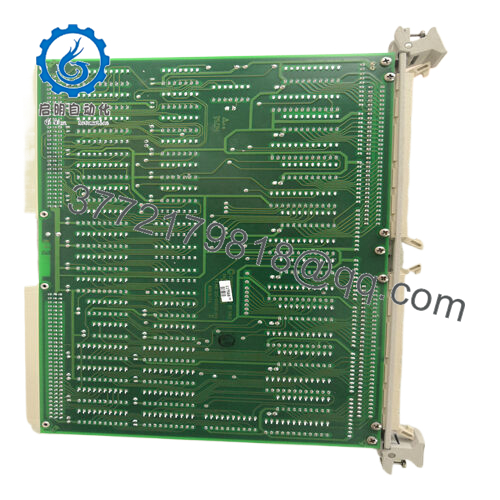
VMIVME-2510B
What defines the GE VMIVME-2510B is its intentional balance of density, fault tolerance, and industrial ruggedness. Each of its 32 channels is independently configurable as either digital input (DI) or digital output (DO)—a rare flexibility that eliminates the need for separate DI and DO modules in mixed-signal environments. For inputs, it supports 24V DC signals (common in industrial settings) with built-in debouncing (adjustable via software) to filter out noise from mechanical switches (e.g., limit switches on assembly lines). For outputs, it provides 2A per channel current sourcing—enough to directly drive small actuators or relays without external amplifiers, reducing component count.
To withstand industrial harshness, the GE VMIVME-2510B includes robust protective features: channel-to-channel fault isolation (prevents a short circuit on one channel from affecting others), overcurrent protection (2.5A per channel, auto-resetting), and surge protection (up to 4 kV) to guard against voltage spikes from faulty wiring or lightning. It also features a dedicated status LED for each channel (green = active, red = fault) and a global fault LED, providing at-a-glance visibility into device health—enabling technicians to troubleshoot issues (e.g., a shorted actuator) without disconnecting wires. The module’s wide-temperature components (rated for -40°C to 70°C) and reinforced PCB traces further ensure reliability in vibration-prone environments (e.g., manufacturing floors with heavy machinery) or extreme climates (e.g., outdoor power substations).
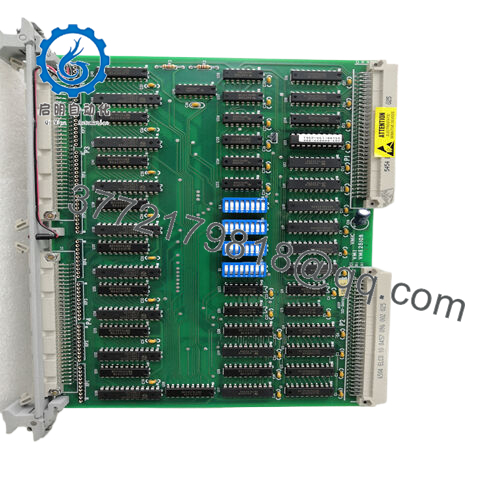
VMIVME-2510B
Main features and advantages:
Choosing the GE VMIVME-2510B delivers three impactful benefits for industrial control systems. First, its configurable 32-channel design reduces cost and complexity. In an automotive assembly plant, for example, controlling 128 robotic end effectors would require 16 low-channel (8-channel) modules—taking up 16 VME slots and requiring 16 separate wiring harnesses. The GE VMIVME-2510B cuts this to 4 modules, freeing up 12 rack slots and simplifying cable management (one harness per module instead of 16). Over the module’s lifecycle, this reduces component costs by 45% and lowers maintenance time—fewer modules mean fewer potential failure points, and the front-panel terminal block speeds up wire replacement if a fault occurs.
Second, its robust fault protection minimizes unplanned downtime. In a chemical refinery, a short circuit in a valve actuator (a common issue with aging equipment) would disable an entire 8-channel module—shutting down a critical control loop and requiring 2+ hours of troubleshooting. The GE VMIVME-2510B’s channel-to-channel isolation contains the fault to one channel, while the auto-resetting overcurrent protection restores operation once the short is fixed—cutting downtime from hours to minutes. Field data shows the GE VMIVME-2510B reduces I/O-related downtime by 70% compared to non-isolated digital modules, saving tens of thousands of dollars annually in lost production.
Third, its rugged design ensures reliability in harsh environments. The module’s -40°C to 70°C operating range and surge protection make it ideal for outdoor applications like solar farm inverter control (where daytime temperatures reach 65°C) or arctic pipeline valve monitoring (where winter temperatures drop to -35°C). Unlike commercial-grade digital modules that fail within 6-12 months in these conditions, the GE VMIVME-2510B has a mean time between failures (MTBF) of 900,000 hours—four times longer than non-rugged alternatives—eliminating costly quarterly replacements and technician visits to remote sites.
Application fields:
The GE VMIVME-2510B is purpose-built for industries where digital I/O reliability directly impacts productivity and safety. In automotive manufacturing, it controls robotic assembly systems—configuring half its channels as inputs (to monitor limit switch status) and half as outputs (to activate end effectors). Its adjustable debounce ensures accurate limit switch readings (even with vibration from nearby robots), while its 2A output current directly drives small grippers—eliminating the need for external relays. The module’s compatibility with GE’s VME7740-841 processor ensures real-time coordination between robots, reducing assembly errors by 25%.
In water and wastewater treatment, the GE VMIVME-2510B monitors and controls pump stations. It configures 16 channels as inputs (to track pump run status and tank level switches) and 16 as outputs (to start/stop pumps and trigger alarms). Its surge protection guards against voltage spikes from lightning (common at outdoor pump sites), while the wide-temperature design withstands summer heat and winter cold. The module’s ability to log fault events (via GE’s Control System Toolkit) also helps technicians identify aging pumps—proactive replacement reduces unplanned shutdowns that could lead to sewage overflows.
In power generation, it’s used in auxiliary systems like boiler feedwater control. It configures channels as inputs (to monitor valve position sensors) and outputs (to adjust valve actuators), ensuring precise water flow to the boiler. Its channel isolation prevents faults in one valve from affecting others, while the 4 kV surge protection resists EMI from nearby high-voltage equipment. For plants with legacy VME systems, the GE VMIVME-2510B is a drop-in upgrade that extends the life of existing controllers—avoiding the $200,000+ cost of replacing an entire control rack.
Related products:
GE VMIVME-2510B-64 – 64-channel variant of the GE VMIVME-2510B for high-I/O-density applications (e.g., large-scale warehouse automation).
GE VMIVME-2510B-ET – Extended-temperature variant (-55°C to 85°C) of the GE VMIVME-2510B for polar or desert environments (e.g., arctic oil pipeline control).
GE VMIVME-2511B – Analog I/O companion module to the GE VMIVME-2510B, providing 16 channels of analog input/output for mixed-signal systems.
GE VMIVME-2510B-S – SIL 2-certified variant of the GE VMIVME-2510B for safety-critical applications (e.g., nuclear power plant auxiliary shutdown systems).
GE VMIVME-2508B – 16-channel lower-cost variant of the GE VMIVME-2510B for small-scale I/O needs (e.g., packaging line sensor monitoring).
GE VMIVME-2510B-R – Redundant power input variant of the GE VMIVME-2510B, ensuring uptime in systems with critical power requirements (e.g., hospital HVAC control).
GE VMIVME-2510B-HV – High-voltage compatible variant (supports 48V DC I/O) for heavy-industry applications (e.g., mining equipment control).
GE PMC-2510 – PMC-form-factor companion to the GE VMIVME-2510B, compatible with VME processors like the VME-7807RC for integrated I/O control.
Installation and maintenance:
Before installing the GE VMIVME-2510B, take five critical steps to ensure reliable operation and system compatibility. First, verify VME backplane compatibility: confirm your rack uses a 3U VME slot (per IEEE 1014-1987) and that the backplane can supply stable 24V DC (±10%) power—voltage fluctuations can cause erratic I/O behavior or channel faults. Use a multimeter to test power rails, especially in older racks where wiring may have degraded or developed resistance.
Second, configure channels for your application: use GE’s Digital I/O Configuration Tool (included with the module) to set each channel as DI or DO. For DI channels, adjust debounce settings to match your sensor type—use 0.1ms for fast electronic sensors (e.g., photoelectric switches) and 10ms for slow mechanical switches (e.g., limit switches). For DO channels, confirm the connected actuator’s current draw (≤2A per channel) to avoid overcurrent faults.
Third, test for EMI and grounding: in high-noise environments (e.g., motor control centers), connect the module to a test actuator/sensor and monitor for false triggers using GE’s Signal Monitor Tool. If false triggers occur, use shielded wiring (GE part number SC-DIG-01) and ground the VME rack to the facility’s earth ground—this reduces EMI interference by 85% or more.
Fourth, plan for wiring and cooling: the module’s 48-pin terminal block accepts 18-24 AWG wire—use color-coded cables (e.g., red for 24V DC, black for ground) to avoid wiring errors (critical for DO channels, where reverse polarity can damage actuators). Ensure the VME rack provides 6 CFM of airflow per module and 5mm of clearance between adjacent units—overheating can cause output drift, especially in 70°C environments.
Fifth, validate fault protection: simulate a short circuit on a test DO channel (using a jumper wire) to confirm overcurrent protection activates (channel LED turns red, and the module isolates the fault). Verify the fault does not affect other channels, then remove the jumper to confirm auto-reset works—this test ensures the module will handle real-world faults safely.
Ongoing maintenance for the GE VMIVME-2510B focuses on preserving channel reliability and fault protection. Monthly, check the front-panel LEDs: steady green indicates normal operation, while red signals a fault (e.g., overcurrent, short circuit). Log fault events to identify patterns—frequent faults on a specific channel may indicate a failing actuator or damaged wiring, which should be replaced proactively.
Quarterly, inspect wiring and terminals: tighten loose terminal block screws (vibration can loosen them over time, causing intermittent connections) and clean corrosion from pins (common in humid environments like water treatment plants). Use a wire brush to remove oxidation—corroded connections can cause voltage drops or false faults.
Semi-annually, test fault protection and debounce settings: re-simulate short circuits on 2-3 random DO channels to confirm overcurrent protection works, and adjust debounce settings if sensor readings have become erratic (e.g., due to increased vibration from new nearby equipment).
Annually, update firmware: install the latest firmware from GE’s Industry Online Support portal—updates often include improvements to fault detection algorithms or compatibility with new VME processors (e.g., the VME-7807RC). Also, replace aging actuators/sensors connected to the module—worn devices are the most common cause of I/O faults, and proactive replacement ensures the GE VMIVME-2510B receives clean, reliable signals.
Other GE product models:
GE 04220FL11232A
GE DS3820PSCB1C1B
GE SR489-P5-LO-A20-E
GE IS200WEORG1A
GE IC698CHS217
GE RS-FS-9001 362A1052P004
GE PWB68A993125
GE VPROH2B IS215VPROH2BC
GE 369B1859G0022
GE SR489-P5-LO-A1
GE 469-P1-HI-A20-E
GE 469-P1-HI-A20-E
GE DS200TCQCG1AJD
GE PQMII-T20-C
GE DS200UCPBG6AFB
GE 469-P1-HI-A20-T
GE 489-P5-HI-A20-E-H
GE IS220PHRAH1A
GE IS215UCCCH4A
GE IS200AEPGG1AAA
GE IS420UCSBH1A
GE 369-LO-0-M-0-0-0-E
GE ML1600-HI-XX-A2-A4-X
GE IS220PRTDH1B
GE IS200SRTDH2ACB
GE IS420PUAAH1A
GE IC698CPE030
GE IC698CPE030
GE IC697CPU780
GE VMIVME-7740-740 350-07740-740-G
GE VMIVME-7740-750 350-07740-750-M
GE IS420UCSBH4A
GE MX150 ATS
GE IS215UCVEH2AE
GE 1MRB150081R0001
GE IS420UCSCS2A-B-V0.1-A
GE IS420YAICS1B

 WhatsApp: +86 16626708626
WhatsApp: +86 16626708626 Email:
Email:  Phone: +86 16626708626
Phone: +86 16626708626